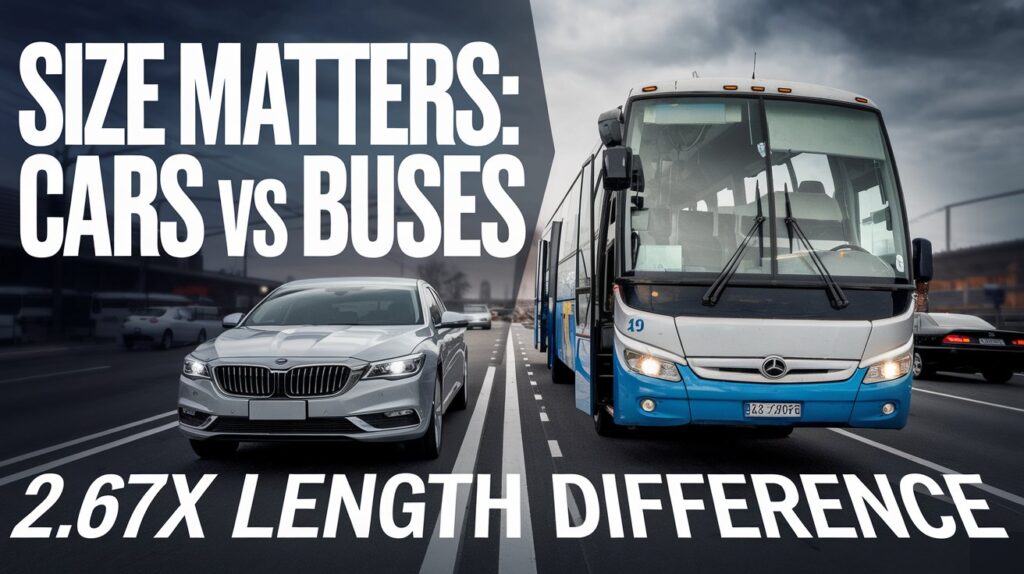When you park next to a city bus on the street, the size difference immediately strikes you. Let’s dive into a detailed How Big is a Standard Car Compared to a Bus and comparison of vehicle dimensions.
Understanding Vehicle Dimensions and Measurement
Today’s roads accommodate vehicles of vastly different sizes, from compact Honda Civics to massive coach buses. Vehicle specifications play a crucial role in how these different-sized vehicles share the road safely. Modern transportation infrastructure must account for everything from tiny smart cars to enormous semi-trucks.

Road design has evolved to accommodate this variety of vehicle sizes. Engineers carefully consider turning radius and clearance requirements when planning streets, intersections, and parking facilities. These measurements affect everything from lane width to garage height restrictions.
Car vs Bus Size Comparison Slider
Regional Size Regulations
Different regions worldwide maintain specific regulations governing vehicle dimensions to ensure safe road operation and infrastructure compatibility.
North American Regulations
Region Maximum Maximum Maximum Special
Length (ft) Width (ft) Height (ft) Considerations
USA 45 8.5 13.5 State variations
apply
Canada 41 8.5 13.1 Provincial rules
differ
Mexico 48 8.5 14.0 Urban restrictions
vary
European Union Standards
Vehicle Type Maximum Maximum Maximum Notes
Length (m) Width (m) Height (m)
Passenger Car 12.0 2.55 4.0 Urban zones may
have restrictions
City Bus 13.5 2.55 4.0 Articulated: 18.75m
Coach Bus 13.5 2.55 4.0 May vary by country
Asian Market Regulations
Country Car Size Bus Size Special Requirements
Limits Limits
Japan Length: Length: Kei car category has
4.7m max 12m max distinct limits
China Based on Length: Varies by city and
vehicle 13.7m max vehicle purpose
class
Check this out :
Weight as an Important Metric
The difference between cars and buses becomes even more striking when we consider their weights. A typical Toyota Camry weighs between 2,500 to 4,000 pounds, while a fully loaded city bus can tip the scales at 20,000 to 30,000 pounds.
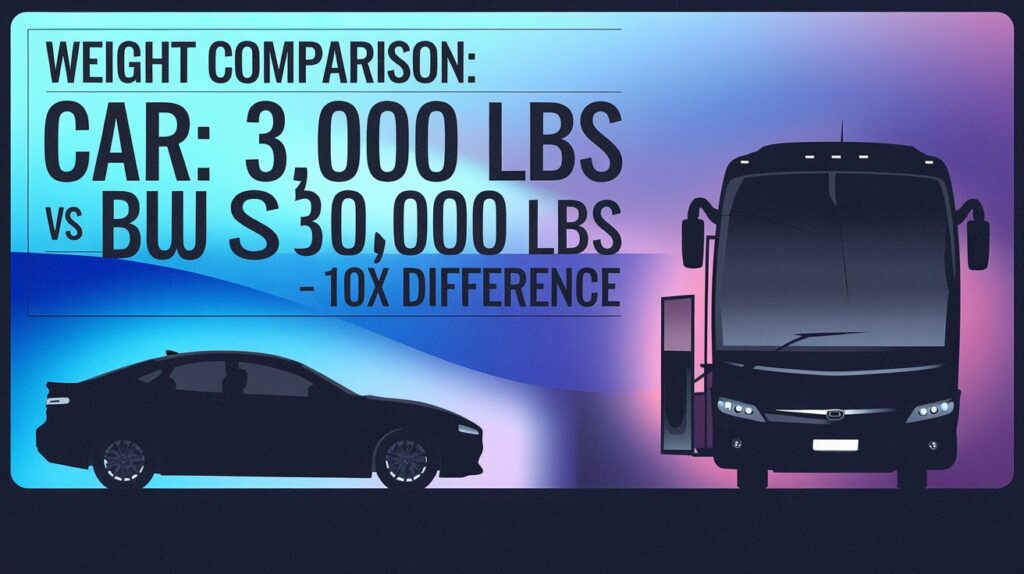
This substantial weight difference affects vehicle handling, fuel economy, and road regulations. The heavier weight of buses requires special driver training, different braking techniques, and carefully planned routes that can handle their mass.
Standard Cars Dimensions Explained
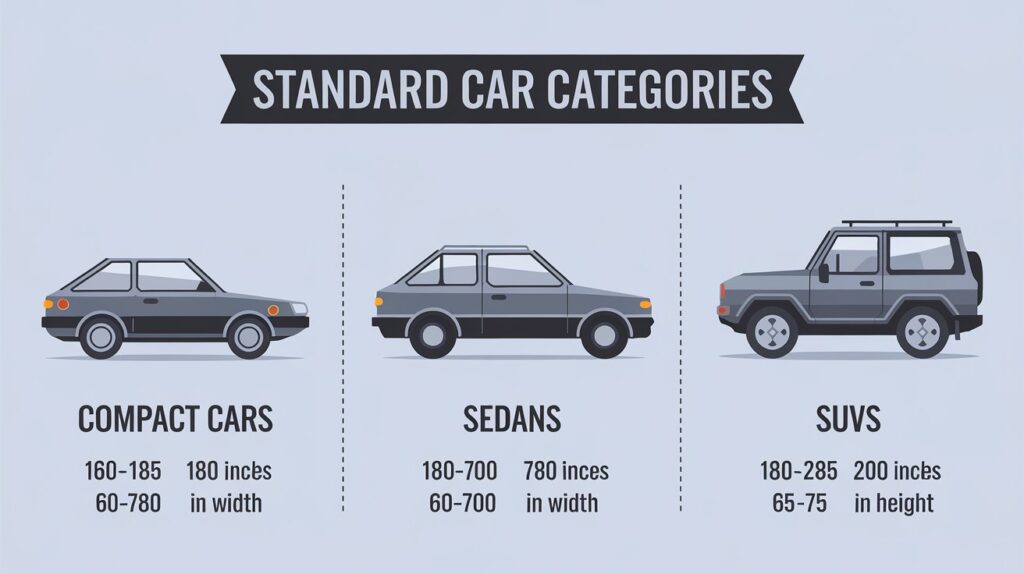
The world of passenger vehicles encompasses a wide range of sizes, but certain standards have emerged over time. A typical Toyota Corolla or Honda Civic represents what most people think of as a standard car size.
Vehicle measurements for standard cars have evolved with consumer preferences and safety regulations. While cars from the 1950s might have been longer, today’s vehicles tend to make more efficient use of their dimensions while maximizing interior space.
What Defines a Standard Car?
The concept of a standard car has shifted over the decades. Today, we generally consider vehicles like the Honda Accord and Toyota Camry as standard-sized cars. These family cars typically measure 14.5 to 16 feet in length, 5.5 to 6.5 feet in width, and 4.5 to 5 feet in height.
Environmental concerns and fuel consumption patterns have influenced car sizes significantly. Manufacturers like Honda and Toyota constantly work to optimize vehicle dimensions for better sustainability while maintaining comfort and safety.
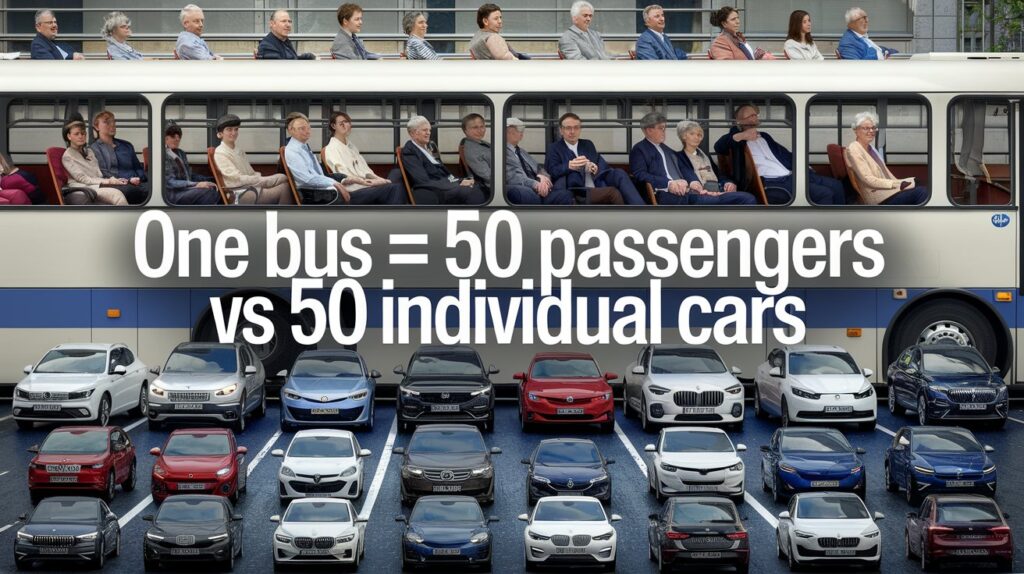
Must Explore :
Average Dimensions of Cars
Let’s break down car dimensions by category:
Vehicle Dimensions Comparison
| Vehicle Type | Length (feet) | Width (feet) | Height (feet) | Average Weight (pounds) |
|---|---|---|---|---|
| Compact Cars | 13.5 – 14.5 | 5.5 – 6.0 | 4.5 – 4.8 | 2,500 – 3,000 |
| Sedans | 14.5 – 16.0 | 5.8 – 6.2 | 4.8 – 5.0 | 3,000 – 3,500 |
| SUVs | 15.0 – 18.0 | 6.0 – 6.5 | 5.5 – 6.0 | 3,500 – 4,000 |
These measurements represent typical ranges for personal transportation vehicles in the American market as of December 4, 2024.
Vehicle Dimension Calculator
Buses Dimensions Explained
When we step into the world of mass transit, dimensions increase dramatically. Public transport vehicles like buses must balance passenger capacity with maneuverability in urban environments.
Modern transportation efficiency demands that buses maximize their interior space while remaining practical for city use. This has led to standardized sizes that work well for different applications, from school runs to cross-country travel.
Different Types of Buses and Their Sizes
The bus world divides broadly into three main categories: city buses, school buses, and coach buses. Each type serves a specific purpose and comes with its own size requirements.
A typical Ford transit bus must navigate tight city streets while carrying 30 to 70 passengers. Meanwhile, school buses need to accommodate 50 to 72 students safely, and coach buses focus on comfort for 40 to 60 passengers on longer journeys.
Bus Passenger Capacity
City Bus
Maximum capacity: up to 70 passengers
School Bus
Maximum capacity: up to 72 passengers
Coach Bus
Maximum capacity: up to 60 passengers
Check this out :
Standard Dimensions for Each Type

Here’s a comprehensive breakdown of bus dimensions:
Bus Dimensions Comparison
| Bus Type | Length (feet) | Width (feet) | Height (feet) | Passenger Capacity |
|---|---|---|---|---|
| City BusPublic Transit | 35 – 45 | 8.0 – 8.5 | 10 – 11 | 30 – 70 |
| School BusStudent Transport | 20 – 40 | 8.0 | 10 – 12 | 50 – 72 |
| Coach BusLong Distance | 35 – 45 | 8.5 | 11 – 13 | 40 – 60 |
The Impact of Size on Urban Planning
Traffic management becomes increasingly complex when dealing with vehicles of such varying sizes. Urban planners must consider everything from turn radiuses to bus stop dimensions.
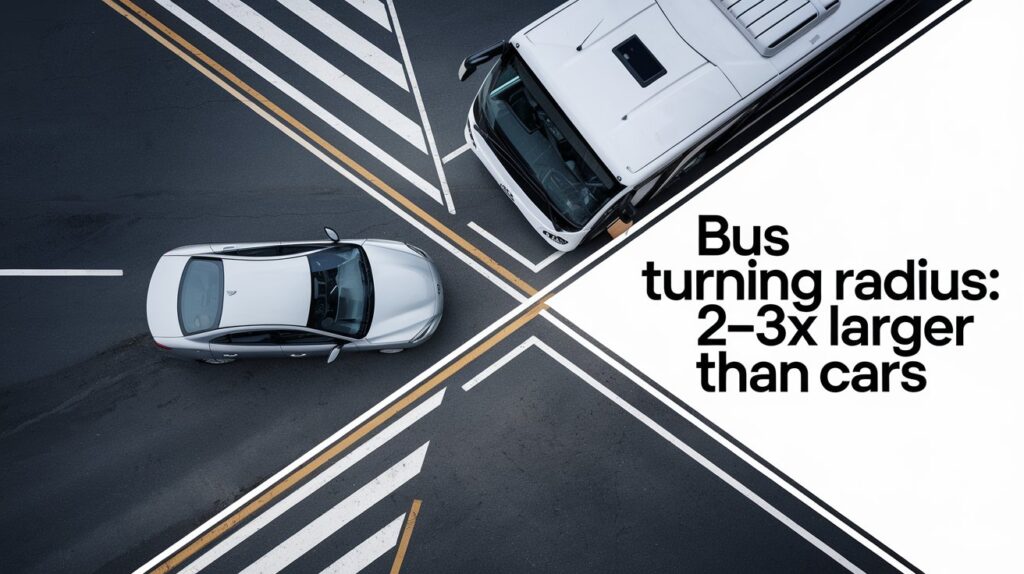
The presence of both cars and buses on city streets influences road design significantly. Lane widths, intersection layouts, and parking facilities must accommodate both vehicle types safely and efficiently.
Safety Considerations in Size Differences
Vehicle safety takes on new dimensions when cars and buses share the road. The difference in mass affects crash dynamics and required braking distance significantly.
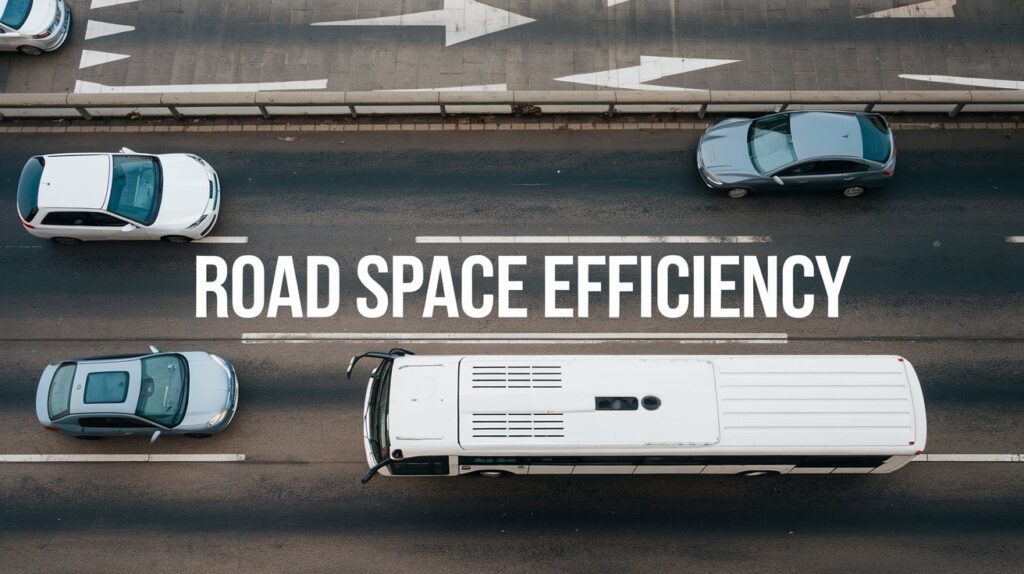
Traffic safety protocols must account for these size disparities. This includes everything from mirror positioning to safe following distances between vehicles of different sizes.
I’ll help you add a section about parking tips and guides to the article. This section would fit well between “Safety Considerations In Size Differences” and “Environmental Impact Of Vehicle Sizes”. Here’s the suggested addition:
Parking Tips And Guidelines For Different Vehicle Sizes
The substantial size difference between cars and buses necessitates different approaches to parking. Understanding these differences is crucial for both safety and efficiency in urban environments.
Car Parking Guidelines:
- Standard parking space dimensions: 9 feet wide by 18 feet long
- Parallel parking space: 22-24 feet long
- Minimum clearance height for car garages: 7 feet
- Recommended distance from other vehicles: 2-3 feet
Bus Parking Requirements:
- Bus parking space dimensions: 12 feet wide by 45-50 feet long
- Pull-through spaces preferred over back-in spots
- Minimum clearance height: 14 feet
- Special consideration for swing radius during turns
Parking Space Comparison
Parking Aspect Standard Car Bus Ratio
- Width Required 9 feet 12 feet 1.33x
- Length Required 18 feet 45-50 feet 2.5-2.8x
- Height Clearance 7 feet 14 feet 2x
- Turn Space 25-30 feet radius 45-50 feet radius 1.7x
Essential Parking Tips:
- Always check clearance heights before entering structures
- Leave extra space for passenger loading/unloading
- Consider door swing space when parking next to other vehicles
- Use spotters when maneuvering large vehicles in tight spaces
- Be aware of overhanging obstacles and low-hanging structures
Environmental Impact of Vehicle Sizes
Larger vehicles like buses typically consume more fuel per vehicle, but their passenger efficiency often makes them more environmentally friendly per person than individual cars.
The environmental impact of different vehicle sizes extends beyond just emissions. Factors like road wear, noise pollution, and resource consumption all vary significantly between cars and buses.
Fuel Efficiency Comparisons
Understanding fuel efficiency differences between cars and buses provides important context for both environmental and economic considerations in transportation planning.
Fuel Consumption Patterns
Vehicle Type Average MPG Fuel Tank Passenger MPG Per
Capacity Capacity Passenger
Compact Car 30-40 MPG 12-14 gal 4-5 6-10 MPG
Standard Sedan 25-35 MPG 14-16 gal 5 5-7 MPG
City Bus 4-6 MPG 60-150 gal 50-70 0.2-0.3 MPG
Coach Bus 6-8 MPG 150-200 gal 40-60 0.15-0.2 MPG
Efficiency Factors To Consider:
- Per-Passenger Efficiency
- While buses consume more fuel overall, their per-passenger efficiency is superior
- A fully loaded bus can replace 30-40 individual cars
- Reduces total carbon footprint per transported passenger
- Urban vs. Highway Performance
- Cars: 20-30% better highway efficiency
- Buses: 15-25% better highway efficiency
- Stop-and-go traffic affects both vehicle types differently
- Economic Considerations
- Fuel cost per mile:
- Standard car: $0.10-0.15/mile
- City bus: $0.85-1.20/mile
- Cost per passenger mile:
- Standard car: $0.02-0.04/mile
- City bus: $0.02-0.03/mile (at full capacity)
- Environmental Impact
- CO2 emissions per passenger mile:
- Standard car: 404g
- Full bus: 82g
- Overall environmental efficiency improves with higher occupancy rates
[Fuel Efficiency Metrics]
Modern Fuel-Saving Technologies:
- Hybrid systems in both cars and buses
- Regenerative braking
- Start-stop systems
- Aerodynamic improvements
- Electric and alternative fuel options
This comparative analysis shows that while individual vehicles may achieve better raw fuel economy numbers, mass transit options like buses often prove more efficient when measured on a per-passenger basis.
The Size Difference Between a Car and a Bus

To put things in perspective, a standard city bus is roughly equivalent in length to three Honda CR-V SUVs placed end to end. The height difference is even more dramatic, with most buses standing about twice as tall as a typical car.
This size difference affects everything from road regulations to parking design. While a standard parking spot accommodates one car comfortably, a bus requires a space equivalent to 3-4 car lengths.
Also Like To Know This :
How Many Cars Fit Inside a Bus?
From a volume perspective, you could theoretically fit several dismantled cars inside a standard bus frame. However, more practically, we can compare their footprints on the road.
The space occupied by one coach bus equals approximately three to four standard passenger vehicles, though this varies depending on the specific models being compared.

Comparison Calculation
Let’s look at a practical comparison using standard measurements:
Car vs Bus Size Comparison
| Aspect | Standard Car (Sedan) | City Bus | Difference Ratio |
|---|---|---|---|
| Length | 15 feet | 40 feet | 2.67x |
| Width | 6 feet | 8.5 feet | 1.42x |
| Height | 5 feet | 11 feet | 2.20x |
| Total Volume | 450 cubic feet | 3,740 cubic feet | 8.31x |
Conclusion
Understanding the size difference between cars and buses helps us appreciate the complexity of modern transportation infrastructure. While a standard car like a Toyota Corolla serves personal transportation needs efficiently, buses provide essential mass transit services that move large groups of people while maximizing road space usage.
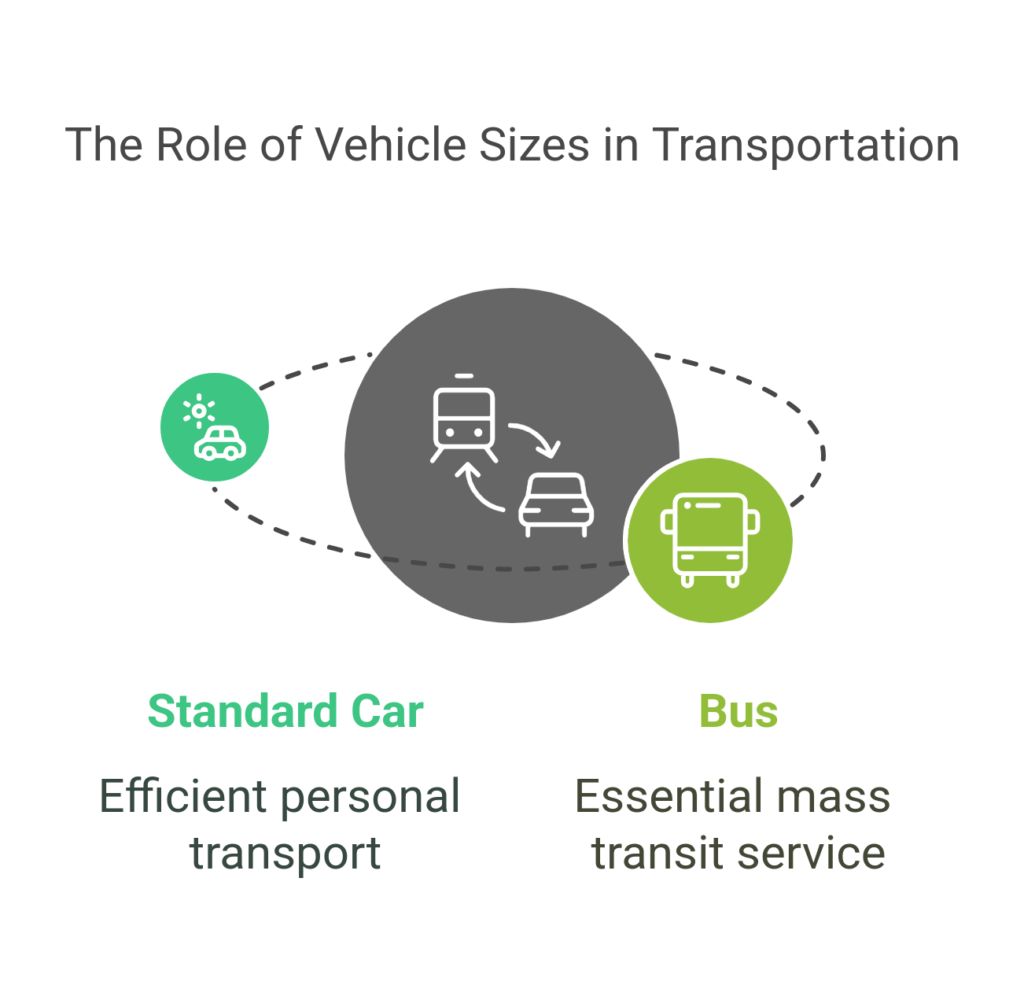
Also like to read this :

John Smith and Kapela Rodriguez, engineering experts and creators of Measured Inches, transform complex measurements into simple, everyday examples. As mechanical and civil engineers, they combine their technical expertise to help readers visualize different units through practical comparisons. Their clear approach has made Measured Inches a trusted resource for understanding measurements.

